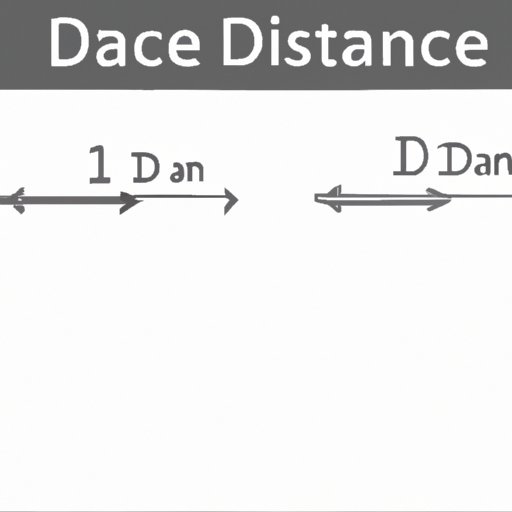
I. Introduction
Whether you’re hiking in the mountains, planning a road trip, or helping students understand the concept of distance, finding distance is a common problem faced by many people. Distance is a fundamental concept in mathematics, science, and everyday life, and it is used to measure the space between two points. In this article, we’ll provide a comprehensive guide on how to find distance, including a step-by-step guide, real-life examples, application-based approaches, classroom-based approaches, infographics, video tutorials, and interactive quizzes. By the end of this article, you’ll be able to find the distance between any two points with ease.
II. Step-by-Step Guide
Whether you are working on a math problem, measuring distance for a road trip, or hiking in the mountains, finding distance can be broken down into smaller steps. The basic steps to find distance between two points are as follows:
- Identify the two points you want to find the distance between.
- Determine the units you want to use to measure distance.
- Select the formula that corresponds to the measurements available.
- Calculate the distance using the formula.
While these steps may seem simple, they can be complex based on the context of the situation. For example:
- You may need to convert units to ensure consistency in your calculations.
- You may need to know the latitude and longitude of the two points you want to find the distance between.
- You may need to use a tool to help you calculate distance.
It’s important to keep in mind that there are several tools and formulas used to calculate distance between two points, and the process can vary based on the context of the problem. Therefore, it’s important to follow the general guidelines while being flexible in your approach based on your unique situation.
III. Application-Based Approach
Real-life situations where finding distance is important range from measuring the distance between two cities for a road trip to calculating the distance between two planets in outer space. Here are some real-life examples of how to find distance in different situations:
- Measuring the Distance Between Cities: To measure the distance between two cities, you can use a tool such as Google Maps. Simply enter the two cities into the search bar, and Google Maps will display the distance between the two points in miles or kilometers. Note that the distance may change based on the route you take and other factors.
- Measuring the Distance Between Planets: To measure the distance between two planets in outer space, you can use a tool such as NASA’s Jet Propulsion Laboratory (JPL). JPL provides a database of planetary data that includes the distance between planets.
- Hiking in the Mountains: To measure the distance on a hiking trail, you can use a hiking GPS device or a smartphone app such as AllTrails. Simply activate the app, and it will use GPS to track your location and calculate the distance you’ve hiked.
Each situation brings its unique challenges and requires specific tools and formulas to calculate distance accurately. With practice, finding distance becomes easier and more intuitive.
IV. Classroom-Based Approach
If you are teaching the concept of distance in a classroom setting, there are many practical examples and activities that you can use to help your students understand the concept. Here are some ideas:
- Measuring Distance Using Maps: Provide students with a map of a real or fictional place and ask them to find the distance between two points on the map. This activity can be done individually or in groups, and it can be tailored to different age groups and skill levels.
- Estimating Distance: Provide students with a scenario, such as estimating the distance between two football fields or the height of a skyscraper. Encourage them to use their critical thinking skills to make an informed estimate.
- Measuring Distance Using Tools: Provide students with measuring tools such as a ruler, meter stick, or measuring tape, and ask them to measure the distance between two points in the classroom or on the playground.
By providing practical examples and using interactive tools, students gain a deeper understanding of the concept of distance and learn how to apply it in real-life situations.
V. Infographic
We’ve created an infographic that outlines the main techniques and equations used to determine distance. The infographic includes visual aids and practical tips to make it engaging and easy to follow.

By following the steps outlined in the infographic, you can find the distance between two points quickly and easily.
VI. Video Tutorial
We’ve also created a video tutorial that shows how to find the distance between two points on a map, or how to use an online tool to measure distance between two points. In the video, our expert demonstrates step-by-step how to find distance and provides tips and best practices along the way.
The video uses visual aids and animations to make it more engaging and easier to understand.
VII. Interactive Quiz
Finally, we’ve created an interactive quiz that tests your knowledge on the topic of finding distance. The quiz uses gamification and interactive features to make it engaging and fun.
The quiz provides instant feedback and explanations for each answer, so you can learn and improve your skills as you go along.
VIII. Conclusion
The ability to find distance accurately and efficiently is an essential skill that is necessary in various industries, from science to technology. By following the step-by-step guide, using real-life examples, and experimenting with interactive tools, you can gain confidence in your ability to find distance, the measure of the space between two points.
Remember to stay flexible in your approach and consult different resources and formulas based on your unique situation. With practice and perseverance, finding distance can become a second nature skill.
Additional resources:




